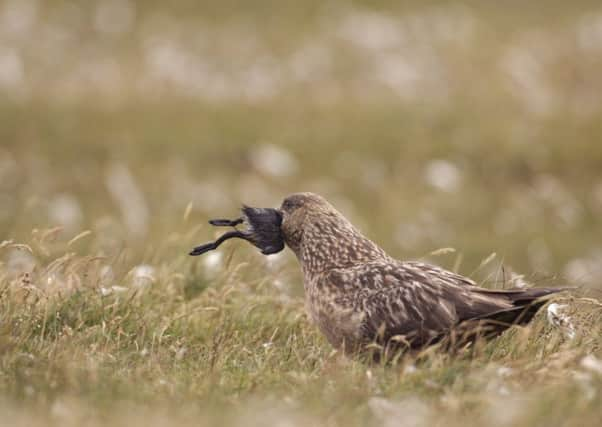Sky ‘pirates’ put puffin at Europe extinction risk


A rogue group of great skuas has developed a taste for puffin meat – and a ruthless method of getting hold of it.
Viewers of the BBC’s Springwatch watched as one of the brown birds held a struggling puffin under the waves to drown it.
Advertisement
Hide AdAdvertisement
Hide AdPuffins are already on a list of species said to be “at risk of extinction” in Europe because of climate change and a shortage of food.
But now it is clear some face a more immediate threat from the ultimate “nightmare neighbours” who share the cliffs on which they nest.
The Springwatch footage was filmed at Hermaness on Unst in Shetland, the most northerly inhabited island in the UK.
Presenter Chris Packham told viewers to expect “drama from a seabird skyscraper in Shetland”.
The piece, from presenter Iolo Williams, started with footage of puffins tugging at the tough grass with their brightly coloured beaks in order to provide a warm lining for the burrows where they raise their pufflings, or puffin chicks.
It then moved on to what Williams described as their “nightmare neighbours” – the great skuas, known in Shetland as bonxies.
Known for being feisty and aggressive, with a wingspan of up to four and a half feet, they ambush other seabirds, forcing them to drop their latest meal. At first they were shown fighting with each other. But they soon turned their attentions to their smaller neighbours.
Williams said: “When it comes to finding food, there are no boundaries. Most seabirds have a diet of fish. But bonxies will eat anything they can get their beaks on. This has earned these avian predators a nickname – the pirates of the sky.
Advertisement
Hide AdAdvertisement
Hide Ad“Some bonxies here have even developed a taste for puffins. The bonxie might have size and strength on its side, but the puffin is quick and agile – and it has an underground burrow to retreat to. But not every puffin gets away safely.”
A sequence followed as a bonxie, its wings outstretched on the surface of the water, held a puffin under the waves to drown it. When its prey stopped struggling, it and another bonxie began to tuck in to the carcass.
Meanwhile on the clifftop a lone puffin, its beak full of grass, apparently waited in vain for its mate to return.
However Williams urged understanding for the creatures.
He said: “In 1831 there were only two nesting pairs here in Hermaness, because they had been heavily persecuted by man. They were given protection and the population has slowly increased to what it is today, nearly 1,000 pairs.
“But remember, it’s only a handful of those birds that kill and eat puffins. I think the success of the bonxie is something to be celebrated.”
But some Twitter users disagreed. One, Professor June Girvin, wrote: “Bloody bonxies.’ Another, Lammy, said: ‘What a bastard.”
Phil Taylor, RSPB Scotland’s seabird recovery officer, said: “Great skuas do kill and eat smaller birds and so although some Springwatch viewers may have found the footage upsetting this is a perfectly natural occurrence and does not have a significant effect on puffin numbers. The greater threat to puffins comes from changes in their prey species, something which is happening in response to warming seas.”